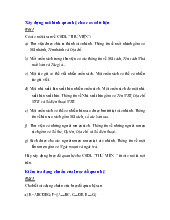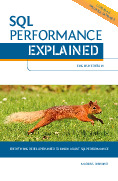


















Preview text:
11/12/2015
Using EXPLAIN to Write Better MySQL Queries
Using EXPLAIN to Write Better MySQL Queries
When you issue a query, the MySQL Query Optimizer tries to devise an optimal plan for query execution. You can see information
about the plan by prefixing the query with EXPLAIN. EXPLAIN is one of the most powerful tools at your disposal for understanding
and optimizing troublesome MySQL queries, but it’s a sad fact that many developers rarely make use of it. In this article you’ll
learn what the output of EXPLAIN can be and how to use it to optimize your schema and queries.
Understanding EXPLAIN’s Output
Using EXPLAIN is as simple as pre-pending it before the SELECT queries. Let’s analyze the output of a simple query to familiarize
yourself with the columns returned by the command. EXPLAIN SELECT categoriesG
********************** 1. row ********************** id: 1 select_type: SIMPLE table: categories type: ALL possible_keys: NULL key: NULL key_len: NULL ref: NULL
chrome-extension://iooicodkiihhpojmmeghjclgihfjdjhj/front/in_isolation/reformat.html 1/19 11/12/2015
Using EXPLAIN to Write Better MySQL Queries rows: 4 Extra: 1 row in set (0.00 sec)
It may not seem like it, but there’s a lot of information packed into those 10 columns! The columns returned by the query are:
id – a sequential identifier for each SELECT within the query (for when you have nested subqueries)
select_type – the type of SELECT query. Possible values are:
SIMPLE – the query is a simple SELECT query without any subqueries or UNIONs
PRIMARY – the SELECT is in the outermost query in a JOIN
DERIVED – the SELECT is part of a subquery within a FROM clause
SUBQUERY – the first SELECT in a subquery
DEPENDENT SUBQUERY – a subquery which is dependent upon on outer query
UNCACHEABLE SUBQUERY – a subquery which is not cacheable (there are certain conditions for a query to be cacheable)
UNION – the SELECT is the second or later statement of a UNION
DEPENDENT UNION – the second or later SELECT of a UNION is dependent on an outer query
UNION RESULT – the SELECT is a result of a UNION
table – the table referred to by the row
type – how MySQL joins the tables used. This is one of the most insightful fields in the output because it can indicate missing
indexes or how the query is written should be reconsidered. Possible values are:
system – the table has only zero or one row
const – the table has only one matching row which is indexed. This is the fastest type of join because the table only has to
be read once and the column’s value can be treated as a constant when joining other tables.
eq_ref – all parts of an index are used by the join and the index is PRIMARY KEY or UNIQUE NOT NULL. This is the next best possible join type.
ref – all of the matching rows of an indexed column are read for each combination of rows from the previous table. This
type of join appears for indexed columns compared using = or <=> operators.
fulltext – the join uses the table’s FULLTEXT index.
chrome-extension://iooicodkiihhpojmmeghjclgihfjdjhj/front/in_isolation/reformat.html 2/19 11/12/2015
Using EXPLAIN to Write Better MySQL Queries
ref_or_null – this is the same as ref but also contains rows with a null value for the column.
index_merge – the join uses a list of indexes to produce the result set. The key column of EXPLAIN‘s output will contain the keys used.
unique_subquery – an IN subquery returns only one result from the table and makes use of the primary key.
index_subquery – the same as unique_subquery but returns more than one result row.
range – an index is used to find matching rows in a specific range, typically when the key column is compared to a constant
using operators like BETWEEN, IN, >, >=, etc.
index – the entire index tree is scanned to find matching rows.
all – the entire table is scanned to find matching rows for the join. This is the worst join type and usually indicates the lack
of appropriate indexes on the table.
possible_keys – shows the keys that can be used by MySQL to find rows from the table, though they may or may not be used in
practice. In fact, this column can often help in optimizing queries since if the column is NULL, it indicates no relevant indexes could be found.
key – indicates the actual index used by MySQL. This column may contain an index that is not listed in the possible_key
column. MySQL optimizer always look for an optimal key that can be used for the query. While joining many tables, it may
figure out some other keys which is not listed in possible_key but are more optimal.
key_len – indicates the length of the index the Query Optimizer chose to use. For example, a key_len value of 4 means it
requires memory to store four characters. Check out MySQL’s data type storage requirements[1] to know more about this.
ref – Shows the columns or constants that are compared to the index named in the key column. MySQL will either pick a
constant value to be compared or a column itself based on the query execution plan. You can see this in the example given below.
rows – lists the number of records that were examined to produce the output. This Is another important column worth focusing
on optimizing queries, especially for queries that use JOIN and subqueries.
Extra – contains additional information regarding the query execution plan. Values such as “Using temporary”, “Using
filesort”, etc. in this column may indicate a troublesome query. For a complete list of possible values and their meaning, check out the MySQL documentation.
chrome-extension://iooicodkiihhpojmmeghjclgihfjdjhj/front/in_isolation/reformat.html 3/19 11/12/2015
Using EXPLAIN to Write Better MySQL Queries
You can also add the keyword EXTENDED after EXPLAIN in your query and MySQL will show you additional information about the way
it executes the query. To see the information, follow your EXPLAIN query with SHOW WARNINGS. This is mostly useful for seeing the
query that is executed after any transformations have been made by the Query Optimizer.
EXPLAIN EXTENDED SELECT CityName City
Country CityCountryCode CountryCode
WHERE CityCountryCode 'IND' CountryContinent 'Asia'G
********************** 1. row ********************** id: 1 select_type: SIMPLE table: Country type: const possible_keys: PRIMARY key: PRIMARY key_len: 3 ref: const rows: 1 filtered: 100.00 Extra:
********************** 2. row ********************** id: 1 select_type: SIMPLE table: City type: ALL possible_keys: NULL key: NULL key_len: NULL ref: NULL
chrome-extension://iooicodkiihhpojmmeghjclgihfjdjhj/front/in_isolation/reformat.html 4/19 11/12/2015
Using EXPLAIN to Write Better MySQL Queries rows: 4079 filtered: 100.00 Extra: Using where
2 rows in set, 1 warning (0.00 sec) WARNINGSG
********************** 1. row ********************** Level: Note Code: 1003
Message: select `World`.`City`.`Name` AS `Name` from `World`.`City` join `World`.`Country` where ((`World`.`City`.`CountryCode` = 'IND')) 1 row in set (0.00 sec)
Troubleshooting Performance with EXPLAIN
Now let’s take a look at how we can optimize a poorly performing query by analyzing the output of EXPLAIN. When dealing with a
real-world application there’ll undoubtedly be a number of tables with many relations between them, but sometimes it’s hard to
anticipate the most optimal way to write a query.
Here I’ve created a sample database for an e-commerce application which does not have any indexes or primary keys, and will
demonstrate the impact of such a bad design by writing a pretty awful query. You can download the schema sample[2] from GitHub. EXPLAIN SELECT orderdetails
INNER orders o orderNumber oorderNumber
INNER products p pproductCode productCode
INNER productlines l pproductLine lproductLine
chrome-extension://iooicodkiihhpojmmeghjclgihfjdjhj/front/in_isolation/reformat.html 5/19 11/12/2015
Using EXPLAIN to Write Better MySQL Queries
INNER customers customerNumber ocustomerNumber WHERE oorderNumber 10101G
********************** 1. row ********************** id: 1 select_type: SIMPLE table: l type: ALL possible_keys: NULL key: NULL key_len: NULL ref: NULL rows: 7 Extra:
********************** 2. row ********************** id: 1 select_type: SIMPLE table: p type: ALL possible_keys: NULL key: NULL key_len: NULL ref: NULL rows: 110
Extra: Using where; Using join buffer
********************** 3. row ********************** id: 1 select_type: SIMPLE table: c type: ALL
chrome-extension://iooicodkiihhpojmmeghjclgihfjdjhj/front/in_isolation/reformat.html 6/19 11/12/2015
Using EXPLAIN to Write Better MySQL Queries possible_keys: NULL key: NULL key_len: NULL ref: NULL rows: 122 Extra: Using join buffer
********************** 4. row ********************** id: 1 select_type: SIMPLE table: o type: ALL possible_keys: NULL key: NULL key_len: NULL ref: NULL rows: 326
Extra: Using where; Using join buffer
********************** 5. row ********************** id: 1 select_type: SIMPLE table: d type: ALL possible_keys: NULL key: NULL key_len: NULL ref: NULL rows: 2996
Extra: Using where; Using join buffer 5 rows in set (0.00 sec)
chrome-extension://iooicodkiihhpojmmeghjclgihfjdjhj/front/in_isolation/reformat.html 7/19 11/12/2015
Using EXPLAIN to Write Better MySQL Queries
If you look at the above result, you can see all of the symptoms of a bad query. But even if I wrote a better query, the results would
still be the same since there are no indexes. The join type is shown as “ALL” (which is the worst), which means MySQL was unable
to identify any keys that can be used in the join and hence the possible_keys and key columns are null. Most importantly, the rows
column shows MySQL scans all of the records of each table for query. That means for executing the query, it will scans 7 × 110 ×
122 × 326 × 2996 = 91,750,822,240 records to find the four matching results. That’s really horrible, and it will only increase
exponentially as the database grows.
Now lets add some obvious indexes, such as primary keys for each table, and execute the query once again. As a general rule of
thumb, you can look at the columns used in the JOIN clauses of the query as good candidates for keys because MySQL will always
scan those columns to find matching records. ALTER TABLE customers PRIMARY customerNumber ALTER TABLE employees PRIMARY employeeNumber ALTER TABLE offices PRIMARY officeCode ALTER TABLE orderdetails
PRIMARY orderNumber productCode ALTER TABLE orders PRIMARY orderNumber customerNumber ALTER TABLE payments
PRIMARY customerNumber checkNumber ALTER TABLE productlines PRIMARY productLine
chrome-extension://iooicodkiihhpojmmeghjclgihfjdjhj/front/in_isolation/reformat.html 8/19 11/12/2015
Using EXPLAIN to Write Better MySQL Queries ALTER TABLE products PRIMARY productCode buyPrice productLine ALTER TABLE productvariants PRIMARY variantId buyPrice productCode
Let’s re-run the same query again after adding the indexes and the result should look like this:
********************** 1. row ********************** id: 1 select_type: SIMPLE table: o type: const
possible_keys: PRIMARY,customerNumber key: PRIMARY key_len: 4 ref: const rows: 1 Extra:
********************** 2. row ********************** id: 1 select_type: SIMPLE table: c type: const possible_keys: PRIMARY key: PRIMARY
chrome-extension://iooicodkiihhpojmmeghjclgihfjdjhj/front/in_isolation/reformat.html 9/19 11/12/2015
Using EXPLAIN to Write Better MySQL Queries key_len: 4 ref: const rows: 1 Extra:
********************** 3. row ********************** id: 1 select_type: SIMPLE table: d type: ref possible_keys: PRIMARY key: PRIMARY key_len: 4 ref: const rows: 4 Extra:
********************** 4. row ********************** id: 1 select_type: SIMPLE table: p type: eq_ref
possible_keys: PRIMARY,productLine key: PRIMARY key_len: 17
ref: classicmodels.d.productCode rows: 1 Extra:
********************** 5. row ********************** id: 1 select_type: SIMPLE
chrome-extension://iooicodkiihhpojmmeghjclgihfjdjhj/front/in_isolation/reformat.html 10/19 11/12/2015
Using EXPLAIN to Write Better MySQL Queries table: l type: eq_ref possible_keys: PRIMARY key: PRIMARY key_len: 52
ref: classicmodels.p.productLine rows: 1 Extra: 5 rows in set (0.00 sec)
After adding indexes, the number of records scanned has been brought down to 1 × 1 × 4 × 1 × 1 = 4. That means for each record
with orderNumber 10101 in the orderdetails table, MySQL was able to directly find the matching record in all other tables using the
indexes and didn’t have to resort to scanning the entire table.
In the first row’s output you can see the join type used is “const,” which is the fastest join type for a table with more than one
record. MySQL was able to use PRIMARY key as the index. The ref column shows “const,” which is nothing but the value 10101 used in the query’s WHERE clause.
Let’s take a look at one more example query. Here we’ll basically take the union of two tables, products and productvariants, each
joined with productline. productvariants table consists of different product variants with productCode as reference keys and their prices. EXPLAIN SELECT
SELECT pproductName pproductCode pbuyPrice lproductLine pstatus lstatus lineStatus products p
INNER productlines l pproductLine lproductLine UNION
SELECT vvariantName productName vproductCode pbuyPrice lproductLine pstatus lstatus lineStatus productvariants v
chrome-extension://iooicodkiihhpojmmeghjclgihfjdjhj/front/in_isolation/reformat.html 11/19 11/12/2015
Using EXPLAIN to Write Better MySQL Queries
INNER products p pproductCode vproductCode
INNER productlines l pproductLine lproductLine products
WHERE status 'Active' lineStatus 'Active' buyPrice BETWEEN 50G
********************** 1. row ********************** id: 1 select_type: PRIMARY table: type: ALL possible_keys: NULL key: NULL key_len: NULL ref: NULL rows: 219 Extra: Using where
********************** 2. row ********************** id: 2 select_type: DERIVED table: p type: ALL possible_keys: NULL key: NULL key_len: NULL ref: NULL rows: 110 Extra:
********************** 3. row ********************** id: 2
chrome-extension://iooicodkiihhpojmmeghjclgihfjdjhj/front/in_isolation/reformat.html 12/19 11/12/2015
Using EXPLAIN to Write Better MySQL Queries select_type: DERIVED table: l type: eq_ref possible_keys: PRIMARY key: PRIMARY key_len: 52
ref: classicmodels.p.productLine rows: 1 Extra:
********************** 4. row ********************** id: 3 select_type: UNION table: v type: ALL possible_keys: NULL key: NULL key_len: NULL ref: NULL rows: 109 Extra:
********************** 5. row ********************** id: 3 select_type: UNION table: p type: eq_ref possible_keys: PRIMARY key: PRIMARY key_len: 17
ref: classicmodels.v.productCode
chrome-extension://iooicodkiihhpojmmeghjclgihfjdjhj/front/in_isolation/reformat.html 13/19 11/12/2015
Using EXPLAIN to Write Better MySQL Queries rows: 1 Extra:
********************** 6. row ********************** id: 3 select_type: UNION table: l type: eq_ref possible_keys: PRIMARY key: PRIMARY key_len: 52
ref: classicmodels.p.productLine rows: 1 Extra:
********************** 7. row ********************** id: NULL select_type: UNION RESULT table: type: ALL possible_keys: NULL key: NULL key_len: NULL ref: NULL rows: NULL Extra: 7 rows in set (0.01 sec)
You can see a number of problem in this query. It scans all records in the products and productvariants tables. As there are no
indexes on these tables for the productLine and buyPrice columns, the output’s possible_keys and key columns show null. The status
of products and productlines is checked after the UNION, so moving them inside the UNION will reduce the number of records. Let’s
add some additional indexes and rewrite the query.
chrome-extension://iooicodkiihhpojmmeghjclgihfjdjhj/front/in_isolation/reformat.html 14/19 11/12/2015
Using EXPLAIN to Write Better MySQL Queries
CREATE INDEX idx_buyPrice productsbuyPrice
CREATE INDEX idx_buyPrice productvariantsbuyPrice
CREATE INDEX idx_productCode productvariantsproductCode
CREATE INDEX idx_productLine productsproductLine EXPLAIN SELECT
SELECT pproductName pproductCode pbuyPrice lproductLine pstatus lstatus lineStatus products p
INNER productlines l pproductLine lproductLine pstatus 'Active' lstatus 'Active' WHERE buyPrice BETWEEN UNION
SELECT vvariantName productName vproductCode pbuyPrice lproductLine pstatus lstatus productvariants v
INNER products p pproductCode vproductCode pstatus 'Active'
INNER productlines l pproductLine lproductLine lstatus 'Active' WHERE vbuyPrice BETWEEN productG
********************** 1. row ********************** id: 1 select_type: PRIMARY table: type: ALL possible_keys: NULL key: NULL key_len: NULL ref: NULL rows: 12 Extra:
chrome-extension://iooicodkiihhpojmmeghjclgihfjdjhj/front/in_isolation/reformat.html 15/19 11/12/2015
Using EXPLAIN to Write Better MySQL Queries
********************** 2. row ********************** id: 2 select_type: DERIVED table: p type: range
possible_keys: idx_buyPrice,idx_productLine key: idx_buyPrice key_len: 8 ref: NULL rows: 23 Extra: Using where
********************** 3. row ********************** id: 2 select_type: DERIVED table: l type: eq_ref possible_keys: PRIMARY key: PRIMARY key_len: 52
ref: classicmodels.p.productLine rows: 1 Extra: Using where
********************** 4. row ********************** id: 3 select_type: UNION table: v type: range
possible_keys: idx_buyPrice,idx_productCode key: idx_buyPrice
chrome-extension://iooicodkiihhpojmmeghjclgihfjdjhj/front/in_isolation/reformat.html 16/19 11/12/2015
Using EXPLAIN to Write Better MySQL Queries key_len: 9 ref: NULL rows: 1 Extra: Using where
********************** 5. row ********************** id: 3 select_type: UNION table: p type: eq_ref
possible_keys: PRIMARY,idx_productLine key: PRIMARY key_len: 17
ref: classicmodels.v.productCode rows: 1 Extra: Using where
********************** 6. row ********************** id: 3 select_type: UNION table: l type: eq_ref possible_keys: PRIMARY key: PRIMARY key_len: 52
ref: classicmodels.p.productLine rows: 1 Extra: Using where
********************** 7. row ********************** id: NULL select_type: UNION RESULT
chrome-extension://iooicodkiihhpojmmeghjclgihfjdjhj/front/in_isolation/reformat.html 17/19 11/12/2015
Using EXPLAIN to Write Better MySQL Queries table: type: ALL possible_keys: NULL key: NULL key_len: NULL ref: NULL rows: NULL Extra: 7 rows in set (0.01 sec)
As you can see in the result, now the number of approximate rows scanned is significantly reduced from 2,625,810 (219 × 110 ×
109) to 276 (12 × 23), which is a huge performance gain. If you try the same query, without the previous re-arrangements, simply
after adding the indexes, you wouldn’t see much of a reduction. MySQL isn’t able to make use of the indexes since it has the WHERE
clause in the derived result. After moving those conditions inside the UNION, it is able to make use of the indexes. This means just
adding an index isn’t always enough; MySQL won’t be able to use it unless you write your queries accordingly. Summary
In this article I discussed the MySQL EXPLAIN keyword, what its output means, and how you can use its output to construct better
queries. In the real world, it can be more useful than the scenarios demonstrated here. More often than not, you’ll be joining a
number of tables together and using complex WHERE clauses. Simply added indexes on on a few columns may not always help, and
then it’s time to take a closer look at your queries themselves.
Image via Efman[3] / Shutterstock[4] Links
chrome-extension://iooicodkiihhpojmmeghjclgihfjdjhj/front/in_isolation/reformat.html 18/19 11/12/2015
Using EXPLAIN to Write Better MySQL Queries
1. vhttp://dev.mysql.com/doc/refman/5.0/en/storage-requirements.html
2. https://github.com/phpmasterdotcom/UsingExplainToWriteBetterMySQLQueries
3. http://www.shutterstock.com/gallery-442516p1.html
4. http://www.shutterstock.com/
chrome-extension://iooicodkiihhpojmmeghjclgihfjdjhj/front/in_isolation/reformat.html 19/19



